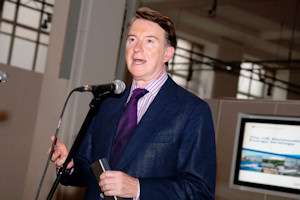09 Dec 2023
The Government and the Northwest Regional Development Agency (NWDA) is investing £8 million to expand existing civil nuclear research facilities within The University of Manchester.

The funding has been announced by Lord Mandelson, Secretary of State for Business, Innovation and Skills, as part of the Government's commitment to new low carbon sustainable growth.
The £8 million investment is to support the University of Manchester’s role in the establishment of the Nuclear Advanced Manufacturing Research Centre (NAMRC). Working in partnership with The University of Manchester’s Dalton Nuclear Institute, the NAMRC will be led by the University of Sheffield together with industrial partners Rolls-Royce.
The NAMRC will comprise a new £25 million building, funded by central government and Yorkshire Forward, located at the Manufacturing Technology Park on the Sheffield / Rotherham border.
The University of Manchester’s main role within the NAMRC will be to lead on the research agenda, drawing on its internationally recognised nuclear research capability.
The fundamental aim of the NAMRC is to innovate, demonstrate and disseminate advanced manufacturing technologies to enable the UK supply chain to seize the opportunities that new nuclear build affords.
Alongside the announcement of the NAMRC, and investment in Manchester’s research facilities, is the establishment of the Nuclear Low Carbon Economic Area (LCEA) in the North West and Yorkshire, led by NWDA in collaboration with Yorkshire Forward.
As part of the Nuclear LCEA the North West will support the Manufacturing Advisory Service's (MAS) nuclear services as part of the Nuclear LCEA, offering manufacturing companies advice and support to access the nuclear energy market.
President and Vice Chancellor of The University of Manchester, Professor Alan Gilbert said: “The University of Manchester fully supports the drive towards a low carbon future and is committed to mobilising its leading nuclear research capability through the Dalton Nuclear Institute to make a substantial contribution to the LCEA agenda through the Nuclear Advanced Manufacturing Research Centre.”
Prof Colin Bailey, Vice President and Dean of the Faculty of Engineering and Physical Sciences at The University of Manchester, said: “The University of Manchester’s leading research into civil nuclear is recognised world-wide and this latest £8 million government investment will enable the University to expand its facilities further.
“As a partner in the Nuclear Advanced Manufacturing Research Centre, and leading on the nuclear research agenda, the University will be able to efficiently deliver the latest research knowledge to the manufacturing industry to ensure the development of a safe UK supply chain to fully service the future civil nuclear new-build.”
Lord Mandelson said: “We know that we have to make the transition to a low carbon future, and the Government is determined to ensure that British businesses get the support they need to seize the business opportunities that transition creates.
"The civil nuclear sector is one of the key low carbon industries where the UK has the potential for job creation, economic growth and engineering and manufacturing excellence. Today's announcement is about investing in our future. A greener, smarter, more skilled, more balanced British economy.”
Business Minister Lord Drayson said: "Low Carbon Economic Areas will help us focus investment, skills and infrastructure regionally to boost the UK's national capacity. This nuclear low carbon economic area will combine the advantages of nuclear infrastructure in the North West and advanced manufacturing in Yorkshire, the advanced manufacturing base in the region and the excellent skills and research bases in Manchester and Sheffield universities. By drawing together our activity regionally we can accelerate our capability nationally."
Notes for editors
For more information please contact Alex Waddington, Media Relations, University of Manchester, 0161 275 8387 / 07717 881569.
SOURCE